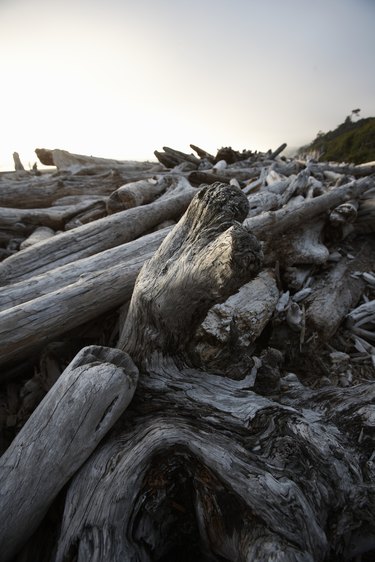
Driftwood is a natural type of wood found in the outdoors where it has been allowed to fall and "drift" according to nature's whim on the shores of seas, lakes, rivers, creeks and other bodies of water. It can be used to create a variety of home furniture, and is prized because of its rustic appearance.
Working With the Wood
Video of the Day
Driftwood is not logged wood, and if you are collecting it from nature yourself, you are working with all the inconsistencies nature provides. This means thin and thick pieces, rough and smooth patches, discolorations, knots and bumps, branches sticking out, and different lengths and shapes. While some stores sell machine-tooled driftwood that has been smoothed down and had most of the inconsistencies cut off or removed, for the most part, you have to be willing to work with these differences when building a bed out of the wood. This means the sideboards, for example, might not be the same size, even though you can cut them down to length. It also means mixing and matching to get the right combination for your unique bed.
Video of the Day
General Construction
As a general rule, the best results for a driftwood bed come from the old-fashioned tongue-and-groove method. This is where pieces are slotted into one another with thinner pieces fitting into a slot in another piece, glued into place. Header boards, footer boards and sideboards slot into the end posts at the four corners of the bed. Frame boards for the bottom frame slot into the sideboards. Use lag bolts and wood screws to further anchor the wood together.
Post Selection
All beds require the support of posts to hold up the frame. As a general rule, you should stick to thick posts that are at least 6 inches in diameter, and have little to no cracks or splits running up the posts that could turn them into fractured-off pieces later on. For larger beds -- queen size and beyond -- as well as beds for more than one person, consider posts that are at least 8 inches in diameter to provide sufficient support. Ensure the posts running up for the header and footer are of sufficient width all the way up, since they need to have slots cut into them to support the sideboards, header and footer.
Sideboards, Headboard and Footer
The header, footer and sideboards often are the most difficult aspect of building a driftwood bed, because they are the most visible sections and as such, are the pieces you want to have the most character -- yet at the same time, the best reveal. Ends need to be trimmed down to fit into the slots in the posts, while branches and other elements that stick out need to be cut off and sanded down.
Bottom Frame
The frame is what holds the mattress up and also any box spring you might have for the bed. While you can create a roughly-rectangular frame with driftwood, understand that the limitation of the wood means your dimensions will not be perfect. Build the frame slightly larger than what you need so the box spring and/or mattress fits into the frame. For best results, place at least four different 4-inch-thick support pieces running across the bed from side to side, and choose the flattest, straightest pieces you found.